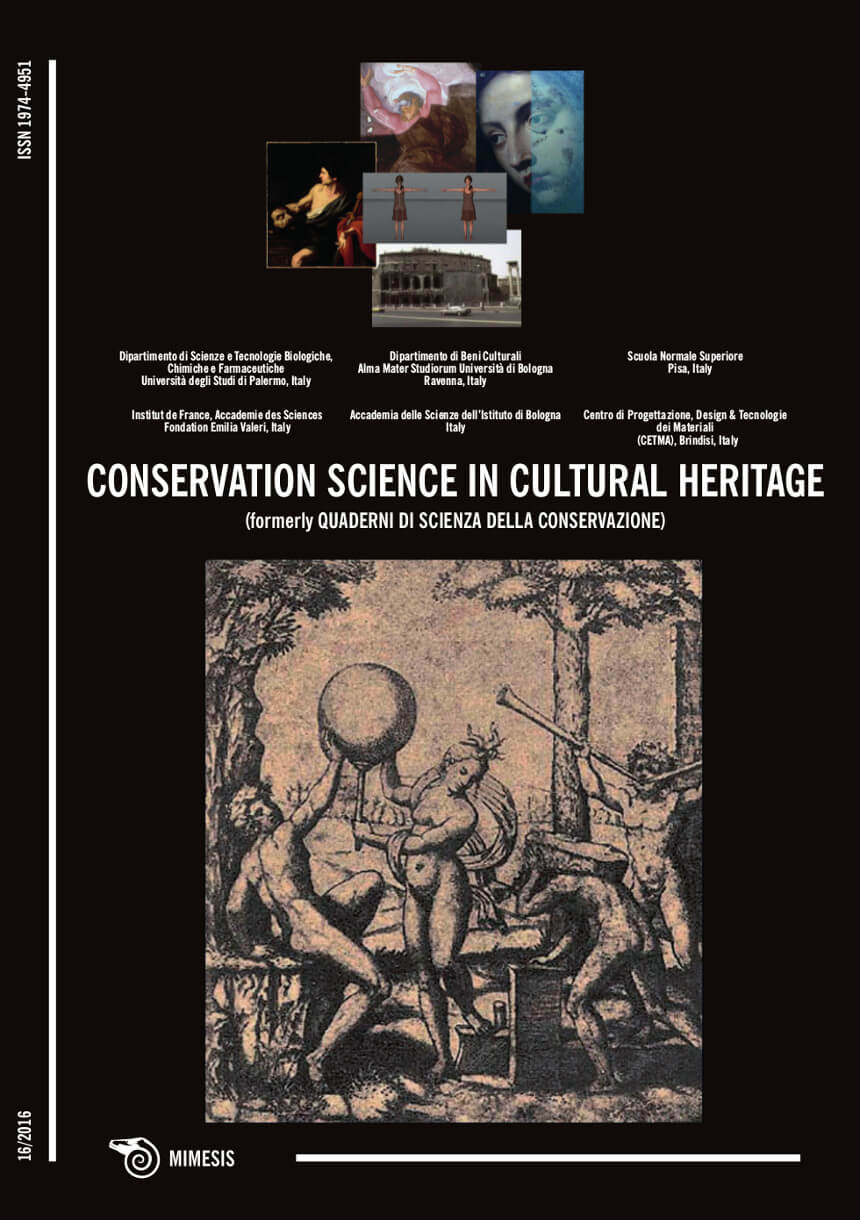Characterization of Historica Lime Mortar from the Spanish Colonial Period in the Philippines
DOI:
https://doi.org/10.6092/issn.1973-9494/7164Keywords:
lime mortar, binder, analytical chemistry techniques, cultural heritage preservation, PhilippinesAbstract
Detailed scientific research applied to the field of cultural heritage is rarely practiced in the Philippines. This study intends to present a systematic approach to the proper chemical characterization of an old lime mortar sample from a Spanish-era church ruin. The analytical techniques employed were: atomic absorption spectroscopy (AAS), infrared spectroscopy (IR), scanning electron microscopy and energy-dispersive x-ray spectroscopy (SEM-EDX), and thermogravimetric analysis (TGA). Results showed that the binder is mostly calcitic, non-dolomitic and air-hardening lime. A slight hydraulic character was observed due to possible clay impurities. Besides the typical sand mixture in mortars, crushed shell fragments were used as aggregates. Possible organic compounds were also identified. The data obtained from this study is very important in understanding traditional building techniques that can enhance heritage conservation work in the Philippines.References
Adrianoa, P., Santos Silvaa, A., Veigab, R., Mirãoc, J., Candeias, A.E. (2007) Microscopic Characterisation of Old Mortars from the Santa Maria Church In Evora, 11th Euroseminar on Microscopy Applied to Building Materials, Porto, 5-9 June. Portugal.
Alvarez, J.I., Martin, A., Garcia Casado, P.J., Navarro, I., Zornoza, A. (1999) Methodology and Validation of a Hot Hydrochloric Acid Attack for the Characterization of Ancient Mortars. Cement and Concrete Research, 29, pp. 1061-1065.
Cayme, J.M., Asor, Jr, A.N. (2015) Extraction Methods for Quantifying Iron, Calcium and Magnesium in a Historic Brickwork Produced During the Spanish Colonial Period in the Philippines. KIMIKA, 26(1), pp. 28-38.
Cayme, J.M., Asor, Jr, A.N., Alano, M.K.A.T., Miranda, E.T. (2016) Chemical Characterization of Historical Brickwork of the Church Convento in Pagsanjan, Laguna. KIMIKA, 27(1), pp. 30-41.
Ceron, M.J.L. and Eusebio, M.S. (2007) Paggawa ng Apog sa Lumang Bayan, San Teodoro, Oriental Mindoro (Lime Making at the Old Town of San Teodoro, Oriental Mindoro). Test Pit: Chronicle of the University of the Philippines, Archaeological Studies Program, June, No. 10, pp 26-28.
Derrick, M.R., Stulik, D., Landry, J.M. (1999) Infrared Spectroscopy in Conservation Science: Scientific Tools for Conservation. The Getty Conservation Institute, Los Angeles.
Eusebio, M. (2009) Did Our Church Builders Use Egg Whites as Mortar Ingredients?: The Biomolecular Reason Behind Collecting Mortars from Historical Sites. Proceedings of the Society of Philippine Archaeologists Vol. 7, Manila, Philippines: Katipunan Arkeologist ng Pilipinas, Inc., pp. 77-82.
Galende, OSA P.G. (2007) Philippine Church Facades. Quezon City: Vibal Publishing House Inc. (Filipiniana.net) and San Agustin Museum.
Gleize, P.J.P., Motta, E.V., Silva, D.A., Roman, H.R. (2009) Characterization of Historical Mortars from Santa Catarina (Brazil). Cement and Concrete Composites, 31(5), pp. 342-346.
Gleize, P.J.P., Motta, E.V., Silva, D.A., Roman, H.R. (2009) Characterization of Historical Mortars from Santa Catarine (Brazil). Cement and Concrete Composite, 31(5), pp.342-346.
Hartshorn, H. (2012) Dolomitic Lime Mortars: Carbonation complications and Susceptibility to Acidic Sulfates, Available at: http://hdl.handle.net/10022/AC:P:13367 [Accessed: 10/18/2016].
Javellana, SJ R.B., (2010) La Casa de Dios, The Legacy of Filipino-Hispanic Churches in the Philippines. Pasig: Ortigas Foundation, Inc.
Jose, Jr., R.T. (1986) Church Expenses in Nineteenth Century Cavite. Philippine Studies, 34, pp. 360-373.
Jose, Jr., R.T. (2003) Palitada: Skin of the Church. In: Zero In: Skin Surface Essence. Ateneo Art Gallery, Ayala Foundation, Inc., Eugenio Lopez Foundation, Inc., and Museum Pambata Foundation, Inc., pp. 7-52.
Jose, R.T. (1992) Simbahan: Church Art in Colonial Philippines 1565-1898. Ayala Foundation Inc.
Luces, K. (2013) From Treasure to Rubble: Heritage Churches Before and After the Bohol Quake, Available at: http://www.gmanetwork.com/news/story/330979/lifestyle/artandculture/from-treasure-to-rubble-heritage-churches-before-and-after-the-bohol-quake [Accessed: 10/20/2016].
Middendorf, B., Hughes, J.J., Callebaut, K., Baronio, G., Papayianni, I. (2005) Investigation Methods for the Characterization of Historic Mortars - Part 2: Chemical Characterisation (RILEM TC 167-COM). Materials and Structures, 38, pp. 771-780.
Miranda, J., Carvalho, A.P., Pires, J. (2012) Assessment of the Binder in Historical Mortars by Various Techniques, Archaeometry, 54(2), pp. 267-277. Holtz, R. and Kovacs, W. (1981) An Introduction to Geotechnical Engineering. New Jersey: Prentice-Hall, Inc.
Moropoulou, A., Cakmak, A., Lohvyn, N. (2000) Earthquake Resistant Construction Techniques and Materials on Byzantine Monuments in Kiev. Soli Dynamics and Earthquake Engineering, 19(8), pp. 603-615.
Nezerka, V., Slizkova, Z., Tesarek, P., Plachy, T., Frankeova, D., Petranova, V. (2014) Comprehensive Study on Mechanical Properties of Lime-Based Pastes with Additions of Metakaolin and Brick Dust. Cement and Concrete Research, 64, pp. 17-29.
Rai, D.C. and Dhanapal, S. (2013) Bricks and Mortars in Lucknow Monuments of c. 17-18 Century. Current Science, 104(2), pp. 238-244.
Rao, H., Li, B., Yang, Y., Ma, Q., Wang, C. (2015) Proteomic Identification of Organic Additives in the Mortars of Ancient Chinese Wooden Buildings, Analytical Methods, 7, pp. 143-149.
Reddy, B.V.V. and Gupta, A. (2008). Influence of Sand Gradation on the Characteristics of Mortars and Soil-Cement Block Masonry. Construction and Building Materials, 22, pp. 1614-1623.
Villalon, A. (2013) Pride of Place: Guiuan Church, a National Cultural Treasure in Samar, Heavily Damagedby ‘Yolanda’, Available at: http://lifestyle.inquirer.net/137505/guiuan-church-a-national-cultural-treasure-in-samar-heavily-dam-aged-by-yolanda [Accessed 10/20/2016].
Downloads
Published
How to Cite
Issue
Section
License
Copyright (c) 2016 Jan-Michael C. Cayme, Aniano N. Jr. Asor
Copyrights and publishing rights of all the texts on this journal belong to the respective authors without restrictions. Authors grant the journal right of first publication.
This journal is licensed under a Creative Commons Attribution 4.0 International License (full legal code).
See also our Open Access Policy.






